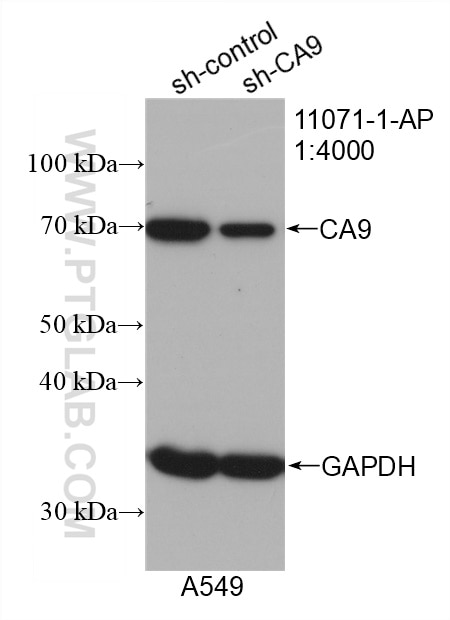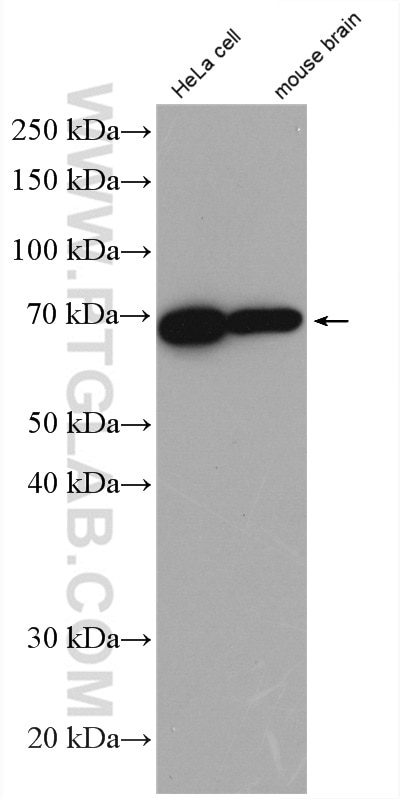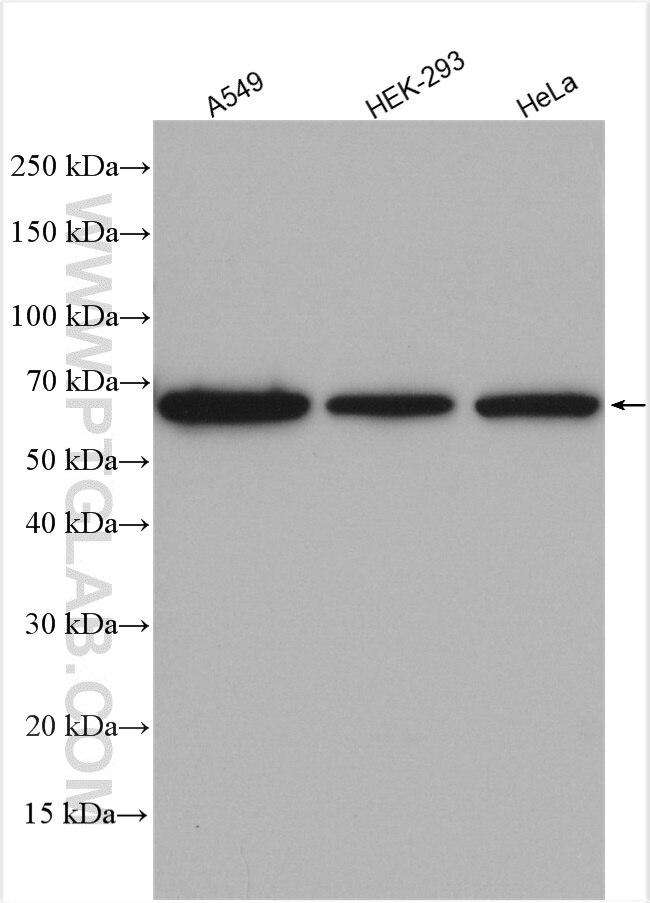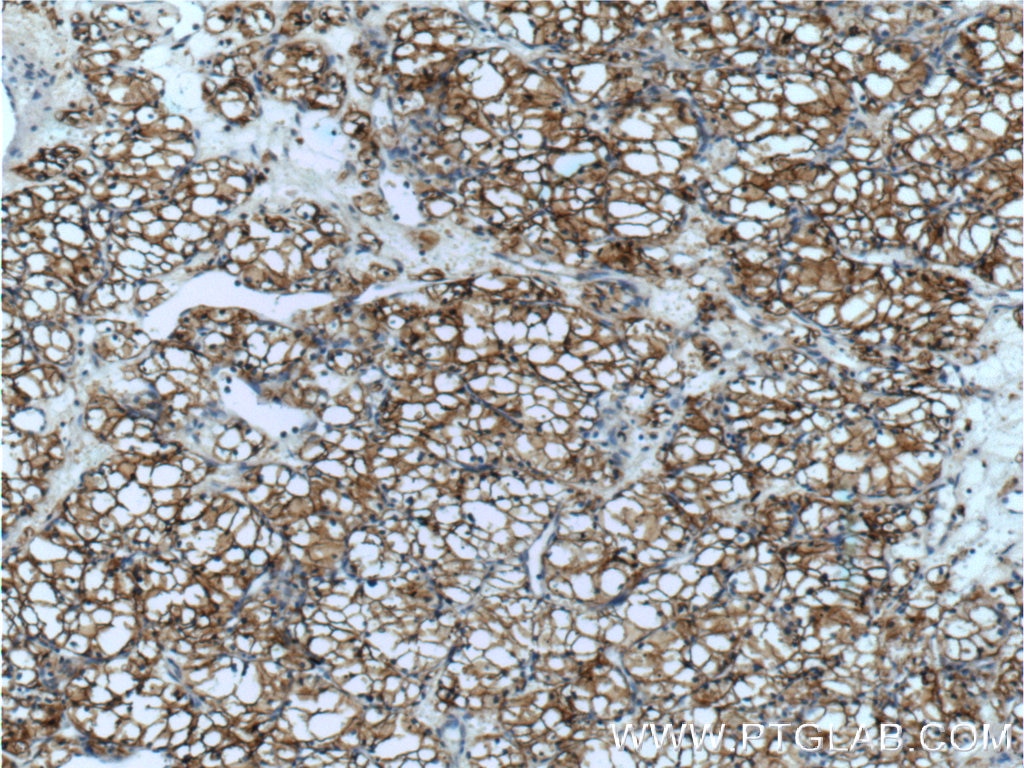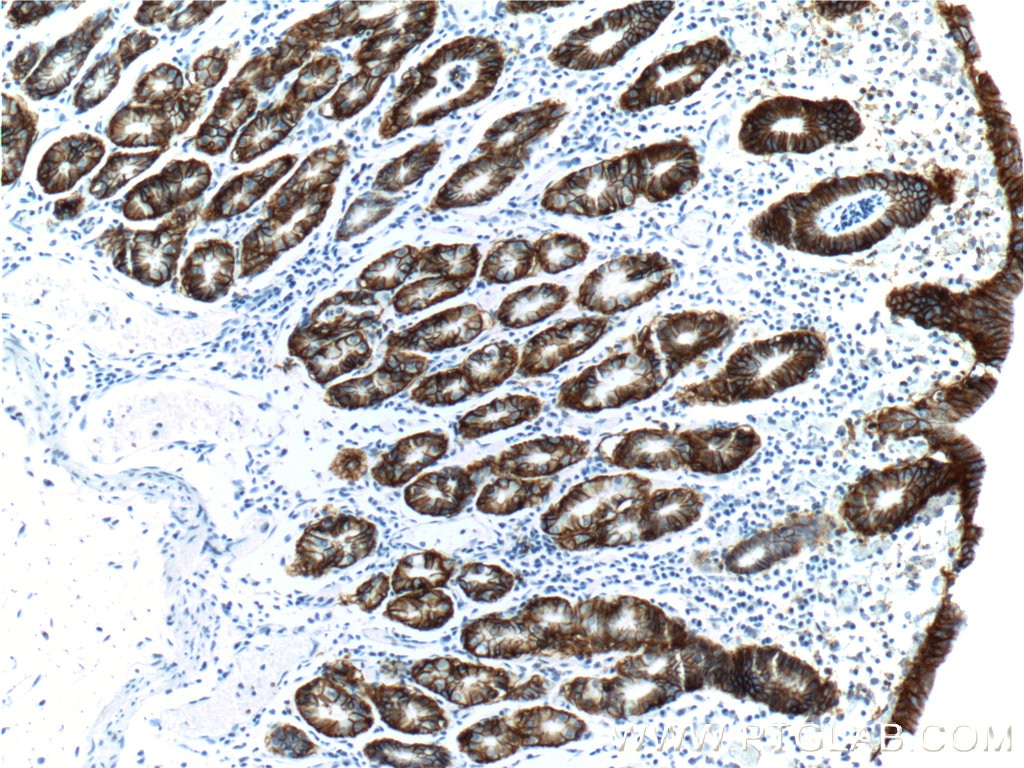- Featured Product
- KD/KO Validated
CA9 Polyklonaler Antikörper
CA9 Polyklonal Antikörper für WB, IHC, IP, ELISA
Wirt / Isotyp
Kaninchen / IgG
Getestete Reaktivität
human, Maus, Ratte
Anwendung
WB, IHC, IF, IP, ELISA
Konjugation
Unkonjugiert
Kat-Nr. : 11071-1-AP
Synonyme
Galerie der Validierungsdaten
Geprüfte Anwendungen
| Erfolgreiche Detektion in WB | A549-Zellen, HEK-293-Zellen, HeLa-Zellen, Maushirngewebe |
| Erfolgreiche IP | Mauslebergewebe |
| Erfolgreiche Detektion in IHC | normal stomach, humanes Magengewebe, humanes Nierenzellkarzinomgewebe Hinweis: Antigendemaskierung mit TE-Puffer pH 9,0 empfohlen. (*) Wahlweise kann die Antigendemaskierung auch mit Citratpuffer pH 6,0 erfolgen. |
Empfohlene Verdünnung
| Anwendung | Verdünnung |
|---|---|
| Western Blot (WB) | WB : 1:1000-1:4000 |
| Immunpräzipitation (IP) | IP : 0.5-4.0 ug for 1.0-3.0 mg of total protein lysate |
| Immunhistochemie (IHC) | IHC : 1:800-1:3200 |
| It is recommended that this reagent should be titrated in each testing system to obtain optimal results. | |
| Sample-dependent, check data in validation data gallery | |
Veröffentlichte Anwendungen
| KD/KO | See 1 publications below |
| WB | See 19 publications below |
| IHC | See 23 publications below |
| IF | See 6 publications below |
Produktinformation
11071-1-AP bindet in WB, IHC, IF, IP, ELISA CA9 und zeigt Reaktivität mit human, Maus, Ratten
| Getestete Reaktivität | human, Maus, Ratte |
| In Publikationen genannte Reaktivität | human, Maus |
| Wirt / Isotyp | Kaninchen / IgG |
| Klonalität | Polyklonal |
| Typ | Antikörper |
| Immunogen | CA9 fusion protein Ag1540 |
| Vollständiger Name | carbonic anhydrase IX |
| Berechnetes Molekulargewicht | 459 aa, 50 kDa |
| Beobachtetes Molekulargewicht | 60-70 kDa |
| GenBank-Zugangsnummer | BC014950 |
| Gene symbol | CA9 |
| Gene ID (NCBI) | 768 |
| Konjugation | Unkonjugiert |
| Form | Liquid |
| Reinigungsmethode | Antigen-Affinitätsreinigung |
| Lagerungspuffer | PBS mit 0.02% Natriumazid und 50% Glycerin pH 7.3. |
| Lagerungsbedingungen | Bei -20°C lagern. Nach dem Versand ein Jahr lang stabil Aliquotieren ist bei -20oC Lagerung nicht notwendig. 20ul Größen enthalten 0,1% BSA. |
Hintergrundinformationen
CA9 (Carbonic anhydrase 9) may be involved in the control of cell proliferation and transformation and appears to be a novel specific biomarker for a cervical neoplasia (PMID:18703501). It is a tumor-associated antigen that has been shown to have diagnostic utility in identifying cervical dysplasia and carcinoma.The protein is presentboth on the plasma membrane and in the nucleus of cells and has the molecular. Western blotting detected CA9 protein at a molecular weight of 70 kDa (PMID: 31819036).
Protokolle
| Produktspezifische Protokolle | |
|---|---|
| WB protocol for CA9 antibody 11071-1-AP | Protokoll herunterladen |
| IHC protocol for CA9 antibody 11071-1-AP | Protokoll herunterladen |
| IP protocol for CA9 antibody 11071-1-AP | Protokoll herunterladen |
| Standard-Protokolle | |
|---|---|
| Klicken Sie hier, um unsere Standardprotokolle anzuzeigen |
Publikationen
| Species | Application | Title |
|---|---|---|
Proc Natl Acad Sci U S A CRLX101 nanoparticles localize in human tumors and not in adjacent, nonneoplastic tissue after intravenous dosing. | ||
Biomed Pharmacother Para-toluenesulfonamide, a novel potent carbonic anhydrase inhibitor, improves hypoxia-induced metastatic breast cancer cell viability and prevents resistance to αPD-1 therapy in triple-negative breast cancer | ||
Oxid Med Cell Longev Carbonic Anhydrase IX Controls Vulnerability to Ferroptosis in Gefitinib-Resistant Lung Cancer | ||
Oxid Med Cell Longev Targeting the Ang2/Tie2 Axis with Tanshinone IIA Elicits Vascular Normalization in Ischemic Injury and Colon Cancer. | ||
Eur J Nucl Med Mol Imaging In vivo three-dimensional evaluation of tumour hypoxia in nasopharyngeal carcinomas using FMT-CT and MSOT. | ||
J Invest Dermatol Enhanced Glycogen Metabolism Supports the Survival and Proliferation of HPV-Infected Keratinocytes in Condylomata Acuminata. |
Rezensionen
The reviews below have been submitted by verified Proteintech customers who received an incentive for providing their feedback.
FH Josh (Verified Customer) (10-28-2021) | 15 ug of human clear cell renal cell carcinoma cell line RCC4 was resolved on 15% Tris/Glycine and transferred to PVDF membrane. Membrane was blocked in blocking buffer (2% BSA in TBS/0.1% Tween-20) for 1hr at room temperature, followed by overnight incubation with anti-CA9 (1:1000) in blocking buffer at 4oC. After 1hr incubation with anti-Rabbit secondary antibody, membrane was imaged with ECL. Expected band was detected along with several non-specific bands by western blot
 |
FH K (Verified Customer) (08-03-2021) | total cell lysate (50 ug of human HCC cell lines) was resolved on 10% Bis-Tris gel and transferred to nitrocellulose membrane. Membrane was incubated in blocking buffer (5% BSA in TBS/0.1% Tween-20) for 1h. Membrane was incubated with anti-CA9 in blocking buffer (1:500) at 40C overnight. After 1h incubation with appropriate secondary antibody (anti-Rabbit 1:5000) membranes were imaged with ECL and expected band was detected.
 |
FH Paulo (Verified Customer) (03-04-2019) | Total cell lysate (50 ug of human ccRCC cell lines) was resolved on 10% Bis-Tris gel and transferred to PVDF membrane. Membrane was incubated in blocking buffer (5% milk in PBS/0.1% Tween-20) for 1h. Membrane was incubated with anti-CAIX in blocking buffer (1:250) at 4C overnight. After 1h incubation with appropriate secondary antibody (DAKO anti-Rabbit 1:10000) membranes were imaged with ECL and expected band was detected
|

